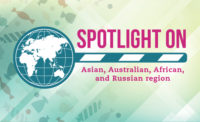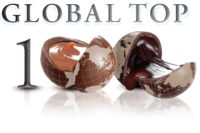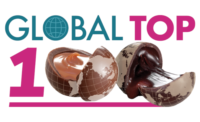The candy industry may be moving a little slower in Asia than the United States and Europe but it is definitely growing, though war in Ukraine may cause rising confectionery prices.
This year’s Top 2022 Asian, Australian, African & Russian Confectioners — which is compiled exclusively by Candy Industry and is based on company finanical data reporting as of April 1, 2022 — shows how the region is managing a tulmultous global economy. Overally, they are managing well.
In fact, five companies listed in our “Top 2022 Asian, Australian, African & Russian Confectioners” list were also among the top 21 companies in Candy Industry’s “Global Top 100 2022.”
Japan has three of those companies. Leading the Asia-Pacific region is the confectionery division of Tokyo’s Meiji Co. Ltd., with $2,918 million in annual sales. Two other Japanese companies, Ezaki Glico, of Osaka, had $1,068 million in sales, and Morinaga, of Tokyo, had $936 million, ranked this year at third and fifth, respectively.
Orion Corp., of Seoul, Korea, is ranked second, with $1,890 million in sales in FY 2020, the last year listed on their website. Orion expanded into India in 2021 with its 18th plant. The other 17 Orion confectionery factories are in South Korea with seven, China with six, Vietnam and Russia with two each, and now Rajasthan, India, according to its company brochure.
The India plant opened in February 2021 and is making the company’s leading global product, Choco Pies. Its confectionery business seems to be increasing in the region for them. In addition to their signature piece, the company also manufacturers chocolate-covered cakes, chocolate-infused snack chips, energy bars, chewing gum, and gummy candies.
Asia set a new record with FY2021 grindings up 5.6 percent over the previous year, according to the Cocoa Association of Asia website. Last year, 877,002 metric tonnes of cocoa beans were ground, which is the highest recorded for the region.
Although China has the second largest economy, their candy consumption is not. China’s chocolate consumption per capita is around 70 grams a year, compared to those in Japan and South Korea who eat about 2 kilograms, and Europeans who eat 7 kilograms, according to Food Navigator-Asia. Yet China is incorporating chocolate into local foods, according to the digital magazine which cited the Association of Chinese Chocolate Manufacturers as using chocolate in bakery and ice cream food stuffs. It may be why ingredient suppliers like Barry Callebaut have increased their presence in the region.
Yahoo! Finance reported last year that China’s confectionery market is expected to reach $45 billion by 2026, while the global confectionery market is expected to reach $233 billion.
Want Want China Holdings, in Shanghai, appears to be its largest local confectioner with $850 million in sales, including non-confectionery items.
Japan has two other large confectioners, Bourbon Corp., of Niigata, with $813 million in sales, and UHA Mikakuto Co., of Osaka, with $284 million.
Tokyo-based confectioner, Morinaga, is expanding its operations in the United States and expects growth in the jelly drink business, direct marketing business, and frozen desserts business.
“While the trend toward improving health through food will grow even more globally, we will further accelerate the growth of the wellness products, the launch of new products that meet new consumer needs will be continued to develop,” says Bridgette Kirkpatrick, of Morinaga America, Inc. “We actually felt the potential of the U.S. through the HI-CHEW business and plan to invest our management resources to realize the further expansion of the overall U.S. business.”
Many global companies view the Asia-Pacific market as having potential. Cargill thought the region was important enough to expand its footprint when it acquired Aalst Chocolate, of Singapore, last year.
“The rapidly growing Asian marketplace is increasingly wielding its influence around the globe, sparking inspiration and driving international trends,” says Francesca Kleemans, managing director for Cargill Cocoa and Chocolate Asia-Pacific.
Russians like their candy too. Moscow’s United Confectionary Manufacturers is ranked fourth with an estimated $1,055 million in sales, although this is an older estimate that could not be confirmed at this time.
Right after the pandemic started, Russia like other countries saw an increase in their sales, according to Confectionery Production. It is a bit unclear how much the war in Ukraine has affected these Russian confectioneries since they have not all responded to inquiries.
It is clear, as of the beginning of April, that the Russian ruble has not been devalued as much as analyst thought it would be. The ruble declined in March but went back up in April and is not much worse than it was prior to pandemic closures. In February 2020 one ruble was equal to .016 U.S. dollar. Last December, it was .014. Then the ruble moved to .0076 in March and back up to .012 at the beginning of April. It has teetered between .015 and .017 over the last month.
After Russian’s invasion, several global candy conglomerates have suspended production in Ukraine for safety concerns, and pulled out of Russia all together either as protest or for security.
In addition, many of the confectionery giants worldwide have donated to Ukrainian relief efforts. For instance, Ferrero has provided €1 million for clean water, blankets, basic medical care, and health assistance to families, and Kellogg has donated $1 million to the UN Refugee Agency and the Global FoodBanking Network.
Since Russia and Ukraine are top world exporters of wheat, wheat prices hit a 14-year high by mid-April, according to Fox Business.
In a recent U.S. State Department briefing, it was noted that Russia is also a major exporter of corn, sunflower products, and fertilizer, all of which may affect candymaking abilities and price.
Corn is used in corn syrup, corn starch and other corn-related products that provide sweetness and/or texture to many confections. Wheat is made in many items that are chocolate-coated such as cookies, biscuits, wafers, and pretzels. Sunflower seeds are used in many of the Asian candies as well.
With Ukrainian farmers unable to plant crops, only time with tell how the prices of candy-related supplies will be affected by this ongoing war, sluggish economy from the Coronavirus, and shortages due to supply chain issues.
In other areas of Asia, Turkey is a hotspot for confectioners, with four companies making the list including Solen Cikolata, in Gaziantep, having around $370 million in annual sales.
Istanbul-based Elvan Group also has seen advances with sales topping $320 million annually in its 15 factories and 3,500 employees.
“We have increased our domestic market sales as well as our exports,” says Gulay Cece, events and communication manager at Elvan. “We are taking firm steps towards our goal of being accessible all over the country by increasing our network of both e-commerce and factory outlets.”
Although Cece says the company had been “greatly affected” by the pandemic, inititally, due to trade restrictions and closures, they moved toward “a high sales graphic with our non-stop production” as places opened up and people became vaccinated.
“We continue to sell in the current order, without going out of our normal routine,” Cece reports.
Elvan recently added lollipops, pretzels, jelly beans, marshmallow sandwiches, ice teas, sodas, ice coffees, milkshake products, and energy drinks to its existing product portfolio of chocolates, toffees, and nut products.
The Russian-Ukrainian war is also causing potential issues in Africa. Cote d’Ivoire and Ghana, which make up 60 percent of the global cocoa production, import fertilizers from Russia and Belarus, according to the Cocoa Market Report from the International Cocoa Organization. The ICCO predicts the cost of cocoa production for the next season will increase as the smallholders struggle to pay increasing costs of fertilizer. Freight charges will increase as countries refuse ships from Russia to enter into or onto their territories, ICCO notes, and the increasing costs of crude oil will probably negatively affect their economy.
New to this year’s list is Darrell Lea, subsidiary of Quadrant Private Equity, from Ingleburn, New South Wales, Australia. Jason Clements, general manager of New Zealand and International Darrell Lea, estimates his annual sales over $400 million annually, with over 300 employees and three factories.
“Darrell Lea (has) had a very strong few years during the pandemic extending into new categories while showing strong growth in existing ones,” says Clements. “Key to growth has been streamlining focus and investing in the areas that are working well while removing the noise.
“Innovation remains critical to our business, like all candy manufacturers, and we are fortunate to have a breadth of manufacturing capabilities that allow us to reach into new areas and flavors. Supply chain remains the largest constraint and it will continue to prove problematic into the future. Our supplier relationships and quick pivoting have allowed us to navigate the majority of issues however and we remain thankful to our all our business partners for that.”
Nejati Industrial Group (Anata), of Tabriz, Iran, is also new to the list with approximately $155 million in sales and over 3,000 employees. They manufacture chocolates, caramel, toffee, gum, jelly candies, and marshmallow.




